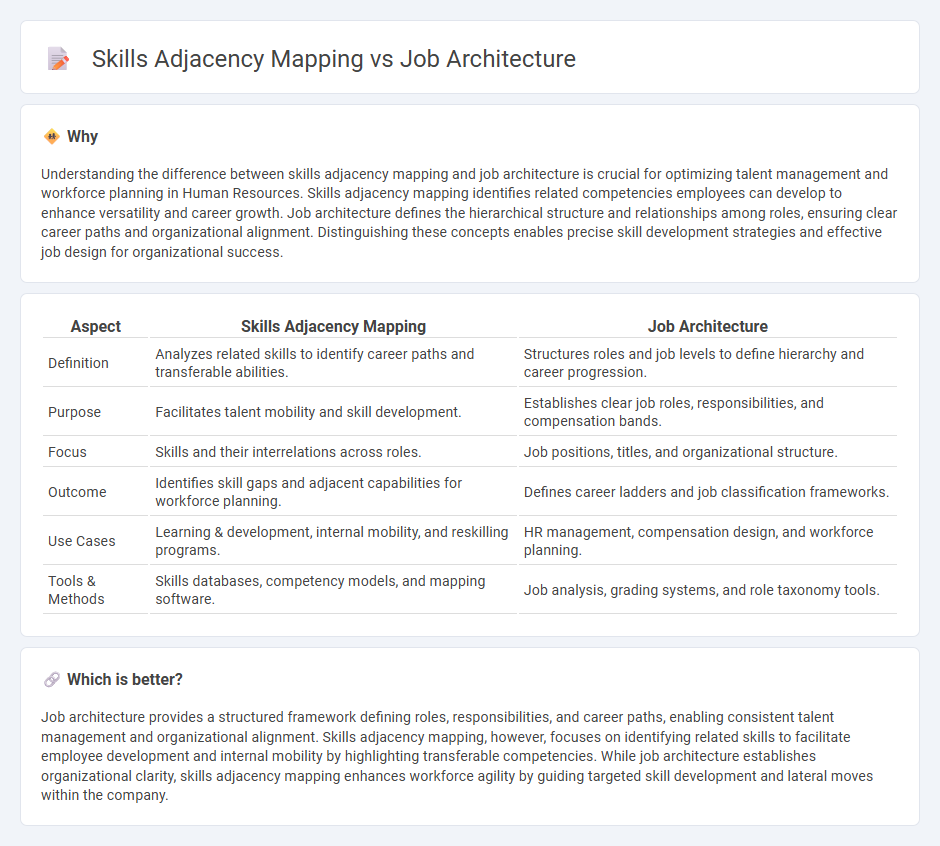
Skills adjacency mapping identifies related competencies to enhance workforce agility and targeted employee development. Job architecture organizes roles by hierarchy, function, and responsibility to streamline career progression and talent management. Explore how integrating both approaches can optimize human resource strategies.
Why it is important
Understanding the difference between skills adjacency mapping and job architecture is crucial for optimizing talent management and workforce planning in Human Resources. Skills adjacency mapping identifies related competencies employees can develop to enhance versatility and career growth. Job architecture defines the hierarchical structure and relationships among roles, ensuring clear career paths and organizational alignment. Distinguishing these concepts enables precise skill development strategies and effective job design for organizational success.
Comparison Table
| Aspect | Skills Adjacency Mapping | Job Architecture |
|---|---|---|
| Definition | Analyzes related skills to identify career paths and transferable abilities. | Structures roles and job levels to define hierarchy and career progression. |
| Purpose | Facilitates talent mobility and skill development. | Establishes clear job roles, responsibilities, and compensation bands. |
| Focus | Skills and their interrelations across roles. | Job positions, titles, and organizational structure. |
| Outcome | Identifies skill gaps and adjacent capabilities for workforce planning. | Defines career ladders and job classification frameworks. |
| Use Cases | Learning & development, internal mobility, and reskilling programs. | HR management, compensation design, and workforce planning. |
| Tools & Methods | Skills databases, competency models, and mapping software. | Job analysis, grading systems, and role taxonomy tools. |
Which is better?
Job architecture provides a structured framework defining roles, responsibilities, and career paths, enabling consistent talent management and organizational alignment. Skills adjacency mapping, however, focuses on identifying related skills to facilitate employee development and internal mobility by highlighting transferable competencies. While job architecture establishes organizational clarity, skills adjacency mapping enhances workforce agility by guiding targeted skill development and lateral moves within the company.
Connection
Skills adjacency mapping identifies related competencies to create a comprehensive view of employee capabilities, enhancing workforce planning accuracy. Job architecture organizes roles, responsibilities, and career paths within an organization, providing a structured framework for talent management. Integrating skills adjacency mapping with job architecture enables precise alignment of employee skills with job requirements, facilitating targeted learning and development strategies.
Key Terms
Job Families
Job architecture organizes roles into job families based on shared responsibilities and competencies, providing a structured career framework for talent management and workforce planning. Skills adjacency mapping identifies related skills within and across job families, enabling targeted upskilling and internal mobility by highlighting transferable capabilities. Explore how integrating job architecture with skills adjacency mapping optimizes talent strategies and enhances organizational agility.
Competency Frameworks
Job architecture structures organizational roles by defining clear job families, levels, and titles, creating a foundation for workforce planning and career progression. Skills adjacency mapping identifies the transferable competencies between roles, enabling efficient talent mobility and targeted development within competency frameworks. Explore how integrating job architecture with skills adjacency mapping enhances strategic talent management and workforce agility.
Career Pathways
Job architecture defines organizational roles, hierarchies, and career levels, providing a structured framework for employee progression. Skills adjacency mapping identifies related competencies across roles, enabling employees to explore lateral and vertical career movements within these pathways. Discover how integrating these tools enhances career development strategies and supports dynamic workforce planning.
Source and External Links
What Is Job Architecture? | HR Glossary - AIHR - Job architecture is a framework that defines and organizes company roles by job titles, responsibilities, skills, compensation structure, job families, job levels, and career paths to ensure consistency, transparency, fairness, and support talent development within an organization.
Job Architecture | Aon - Job architecture organizes a company's functions, job families, jobs, and career levels to ensure internal comparability and foster career mobility while supporting competitive compensation and talent programs.
Designing a Future-Ready Job Architecture Framework - Korn Ferry - Modern job architecture frameworks are evolving toward flexible, skills- and competency-based models that support dynamic career paths, continuous learning, and alignment of pay with skills and market value in response to changing workforce and business needs.
 dowidth.com
dowidth.com